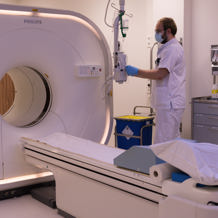Bladder cancer - non-muscle invasive
Muscle invasive bladder cancer knows various stages, and your treatment will depend on the stage of your tumor. A tumor that grows in the bladder tissue but not into the muscle is called non-muscle invasive. This cancer or urothelial carcinoma grows in the lining of the bladder wall and that represents an early stage of the illness. Urothelial carcinoma is the most common type of bladder cancer: approximately 75% of all cases of bladder cancer start with this type. Two other types of bladder cancer are squamous cell carcinoma and adenocarcinoma. Bladder cancer that does grow into the stomach lining is called muscle-invasive bladder cancer.
Visit our NKI Bladder Cancer Center for more information about our expertise, specialists, patient satisfaction rates, news, and innovation.
Find out more about the symptoms and the most commonly used diagnostic tests and treatment types for non-muscle invasive bladder cancer on this page.
 nl
nl
 Nederlands (Nederland)
Nederlands (Nederland)
 English (United States)
English (United States)




